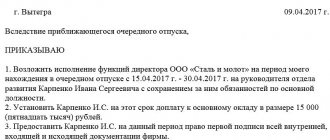Author of the article: Sudakov A.P.
In the process of industrial relations, non-standard situations often arise that require work to be performed without complying with the parameters of working conditions and payment, approved by the internal labor documentation of the business entity. Assigning additional responsibilities to an employee is possible only after obtaining the employee’s consent and completing the appropriate documentation.
It does not take into account whether the additional work qualifies as the main job or not.
Adding additional responsibilities to the main job
Legislative regulation
When assigning additional responsibilities to an employee, one should rely on current legislative norms and internal documentation of the enterprise.
The list of responsibilities of each employee is determined by the terms of the employment contract, the elements of which must be reflected in the job description. When preparing documentation, you should take into account the range of responsibilities regulated by a particular profession and the qualification requirements for it.
If there is a production need to perform work that is not taken into account by the internal regulatory documentation drawn up for a specific employee position, it is necessary to make appropriate changes to it. To do this, it is necessary to adjust the documentation regulating labor relations.
Legal norms
The Labor Code defines the rights of each employee of a business entity to work in accordance with the requirements of a formalized agreement with the employer.
He is not authorized to assign additional duties to hired workers without obtaining their consent. To legally make changes to the documentation regulating changes in labor parameters, it is necessary to notify the employee in writing about the planned changes no later than 2 months before their implementation. Adjustments to duties can only be made after receiving the employee’s written consent after two months from the date of the event.
It is worth noting that if, when the list of works is changed, the employee’s functional responsibilities do not change, then the internal documentation of the enterprise can be changed without the consent of the employees. After the internal documentation has been completed and put into effect, employees must be familiarized with the list of obligations set out in the new edition.
Payment for the duties of an absent employee
The Labor Code does not say how the duties of a temporarily absent employee should be paid, or what the minimum and maximum amount of additional payment should be.
Since this issue is not regulated in any way by law, the responsibility for resolving it falls on the shoulders of the employer himself.
The amount of the additional payment may depend on the amount of additional work transferred to the employee.
Payment for the performance of additional labor duties can be made in the form of an amount or a percentage of the basic salary.
The employer has the right not to pay for the performance of additional duties only if the employee’s employment contract contains a clause according to which a specific position provides for additional work.
Conclusions: if one of the employees leaves a position for a certain/indefinite period (for example: goes on vacation, takes sick leave, goes on maternity leave), the employer can, during his absence, transfer the responsibility for performing his job duties to another employee for additional pay.
The transfer of duties is recorded in two documents - the corresponding agreement and the order on the performance of the duties of the temporarily absent employee. Without the preparation of these documents, the employee’s additional work will not be paid in any way.
Graduated from the Russian State University of Justice (RSUP). Postgraduate student at the Moscow Institute of Public Administration and Law (MGIUP). Since the beginning of 2007, judicial practice, specialization Labor law and labor disputes.
An order to replace an employee during sick leave is an organizational and administrative document that is drawn up to temporarily transfer the duties of an ill employee to another employee.
When additional responsibilities are necessary
Non-standard production situations that require additional obligations to be imposed on employees may be due to the absence of an employee from the workplace, whose responsibilities are transferred to the shoulders of other persons. The reasons for the event may be illness, vacation or medical examination. If the solution to a production problem is within the competence of a specialist who has a specific qualification, a specialty for which is not included in the staffing table, then such obligations can be assigned to an employee who has the appropriate education and skills.
Dependence of labor parameters and remuneration on the applied method of assigning additional responsibilities
An increase in the volume of product output, as well as changes in production regulations, may require additional work not previously provided for by the business entity. New responsibilities may be assigned to an employee within the limits of his competence.
It is important to correctly formalize additional responsibilities for the employee in order to eliminate later disputes regarding remuneration and incompetent performance of duties, which the employee may not be aware of.
How to assign additional responsibilities to an employee
In order to assign additional responsibilities to an employee, it is necessary to act in accordance with an algorithm, the implementation of which will help legally competently solve the production problems that have arisen:
- Drawing up notification of planned changes in working conditions and remuneration. The document must indicate the reason for the actions planned by the employer and the identifying information of the employee in respect of whom all measures will be taken. It is important to indicate the period for which changes are planned.
- Providing the document to the employee for review and signature, which will indicate his consent to work under the new rules.
- Amendments to internal regulations providing for the procedure for imposing additional responsibilities.
- Drawing up an additional agreement to the employment contract. It is recommended that the document reflect a list of imputed additional obligations and the period for which they will be assigned to the employee, as well as the procedure for remuneration. It can be determined as a payment of a fixed amount or as a percentage of a specific salary.
- Making an order.
Algorithm of actions
Procedure for substitution (temporary transfer)
Replacement, like any other procedure related to labor relations, is implemented in several stages. First, you need to talk with the employee to whom the manager plans to assign the duties of the sick person. Afterwards all necessary documents are prepared. Finally, the information is sent to the accounting department, which will charge the appropriate payment.
Is it always necessary to document an order?
According to the requirements of current legislation, an employee can be entrusted with performing the functions of an absent specialist. This will require the person's consent. If the parties have reached an agreement, then the manager issues an order of the appropriate nature, which will be the basis for the calculation of additional payment in the future.
But it is not always necessary to issue an order. In some cases, an order will not be required. This applies to the category of employees who were initially appointed to the position with the condition of possible replacement of a temporarily absent employee, for example, deputy managers. Such a condition must be specified in the contract. As compensation, the employee is given a cash bonus or additional days to the main vacation.
Preliminary discussion
The employee’s consent to replace a temporarily absent person is one of the conditions for the assignment of additional responsibilities. For this reason, the head of the company will need to discuss this issue with the person. During the conversation, the terms of compensation and the scope of additional responsibilities are discussed.
At the same time, Article 72.2 of the Labor Code of the Russian Federation somewhat expands the powers of the manager, granting the right to assign additional responsibilities to the employee without his consent. This is possible in the case of:
- disasters;
- industrial accidents;
- natural Disasters.
Attention! Consent will also not be required if the absence of a specialist will negatively affect the company’s activities, that is, it may lead to a temporary suspension of work, damage or destruction of material assets.
Required documents
The procedure for assigning the duties of a sick employee to another specialist involves the preparation of a number of documents.
These include:
- Report from the immediate superior of the absentee.
- Application for replacement.
- Leader's order.
Information about the temporary replacement of a sick person is not entered into the work book . Information is indicated only on the replacement employee’s registration card.
Service memo
The norms of the Labor Code of the Russian Federation do not directly indicate that it is necessary to draw up a memo in connection with an employee’s illness. But in practice, the local rules of most organizations provide for the preparation of such a document.
The note is drawn up in writing and sent to the head of the company. It should indicate the following:
- Manager details.
- Name of the structural unit.
- Information about the sick employee.
- The date from which he is missing.
Attention! The sick person’s immediate supervisor draws up and signs the memo.
Statement
Another document that can be issued during sick leave is an application for replacement. It is drawn up by an employee who will replace the person who has gone on sick leave and will officially confirm that he is not against performing the duties of a sick colleague.
Like a memo, the application is made in writing. It indicates the start time of sick leave, as well as information about the employee who will temporarily perform duties.
Order to assign duties to another employee
Almost always, an order to assign the duties of a sick specialist to another employee must be issued. The exception is cases when a person is initially a substitute specialist and such a rule is specified in his contract. The order is issued in writing.
The order assigning the duties of a sick specialist to another employee states:
- Name of company.
- Information about the absent and replacement employee.
- Replacement start date.
The order is signed by the head of the company. The document must be reviewed and signed by the replacement employee.
Additional agreement to the TD
An additional agreement to the employment contract may be required. It is issued if a person remains working in the company, but is completely relieved of the duties of his position for the duration of his replacement. The additional agreement, like the employment contract, is drawn up in writing, in two copies. It indicates the period and name of the position for which the replacement will take place.
Payment Features
The procedure for paying specialists who replace sick people is established by Article 151 of the Labor Code of the Russian Federation. It states that additional payment for the assignment of additional duties must be made without fail. The amount of such payment is established by the parties to the labor relationship, taking into account the volume of workload and the deductions made.
Additional responsibilities within one position
The main document regulating the duties of an employee is the Employment Contract.
Legislative norms do not determine the need to prepare a Job Description, so the presence of this document is not required. However, authorized bodies recommend the preparation of such organizational and administrative documentation, since its presence at the enterprise simplifies the organization of work, delineates responsibility and reduces the risk of disagreements regarding assigned obligations.
Since the form and content of the job description are not regulated by law, the document can initially take into account the expanded scope of functional obligations. The content of internal documentation may include:
- qualification requirements;
- an updated list of works that support the economic activities of a business entity;
- actual and planned changes in working conditions.
Many employers are interested in how to assign additional responsibilities to an employee without additional payment. Typically, this procedure is carried out by expanding the list of obligations within one profession.
Assignment of duties that are not classified as qualifications
The Labor Code provides for two ways of assigning duties: internally or part-time.
The final verdict on how to solve production problems lies within the competence of the employer. When making a choice, he focuses on the possibility of allocating additional time to an employee to complete the entire scope of work. In any case, it is necessary to first familiarize the specialist with the new working conditions, based on a sample of the employee’s consent to additional work.
Employee consent to change working conditions
Combination
When registering a combination, the employee, in parallel with the job responsibilities of the main job, performs additionally assigned activities, the implementation of which is regulated by separate instructions.
All work is performed within the established working hours, which does not increase with the introduction of new obligations. Remuneration is set at the discretion of the employer. To give legality to the working relationship, the head of the business entity with the employee must draw up an additional agreement, which can be canceled at any time. It is mandatory to prepare administrative documentation in the form of an order.
Part-time job
When registering an internal part-time job, the employee must be prepared to increase working hours up to the legally defined limit of 4 hours.
Labor is paid in proportion to the time worked. The imposition of additional responsibilities in this way determines the need to conclude another contract, which should contain a section on the procedure for remuneration. It must indicate the amount of additional payment to the official salary that is payable to a specific employee. To remove responsibilities from an employee, the contract must be terminated.
Legislative acts
Labor legislation, its current provisions and acts regulate internal or external movements of personnel both in private enterprises and in state-owned enterprises.
Each possible case is provided for in a specific legislative document, with a clear indication of how a manager should act in relation to his staff.
Different time periods can have different effects on the production course of events in the organization, and management must decide how to most effectively replace an employee.
The following instructions will help with this:
- Art. 60.2 of the Labor Code of the Russian Federation speaks of the possibility of combining professions with an increase in the volume of work performed. If the main specialist is absent, his colleague can perform the functions necessary for the enterprise together with his main job, without leaving it.
- There is a production necessity when it is necessary to reserve a place for a certain employee if he is forced not to attend work. Long-term performance of duties at another production site allows the management to use Article 72.2 for temporary perturbation between positions, for example, to move one for a year to work out the activities necessary for the enterprise, and replace him with a competent specialist.
- The procedure for assigning certain job responsibilities, combining professions and payment for additional functions is established in Article 151 of the Labor Code of the Russian Federation.
Personnel transfers with the obligations of one employee to perform the work of another are carried out after an order from a superior and full agreement between those involved in the procedure.
Order to assign additional responsibilities to an employee
Order imposing additional duties
The form of the order and the procedure for its registration are determined by the current standards for maintaining documentation at the enterprise. The general requirements for administrative documents are the inclusion of mandatory information:
- name of the business entity;
- number, date and place of document preparation;
- the reason on which the duties are assigned;
- a detailed list of assigned obligations;
- terms of remuneration;
- a link to the document, indicating its name and date of registration, which is the basis for drawing up the order;
- manager's signature;
- employee familiarization.
A ready-made sample order to assign additional responsibilities to an employee will help the employer competently draw up administrative documentation. It is important to include in it the necessary sections, the absence of which may lead to controversial situations resolved in court.
Correct drafting of an order
Order on assignment of duties
Proper documentation will allow all participants in the process to be confident that their rights are protected. In addition, it guarantees safety when it comes to government inspections.
The first stage is to obtain consent from the employee in writing. For example, you can make an offer to combine positions.
At the second stage, they begin to draw up the order itself. Here they write about the validity period of the document, describe the responsibilities themselves that you will have to face. It is impossible to do without determining the amount of remuneration.
The order is registered using a special journal, where the document is assigned a separate number. The employee must be familiarized with the document against personal signature.











